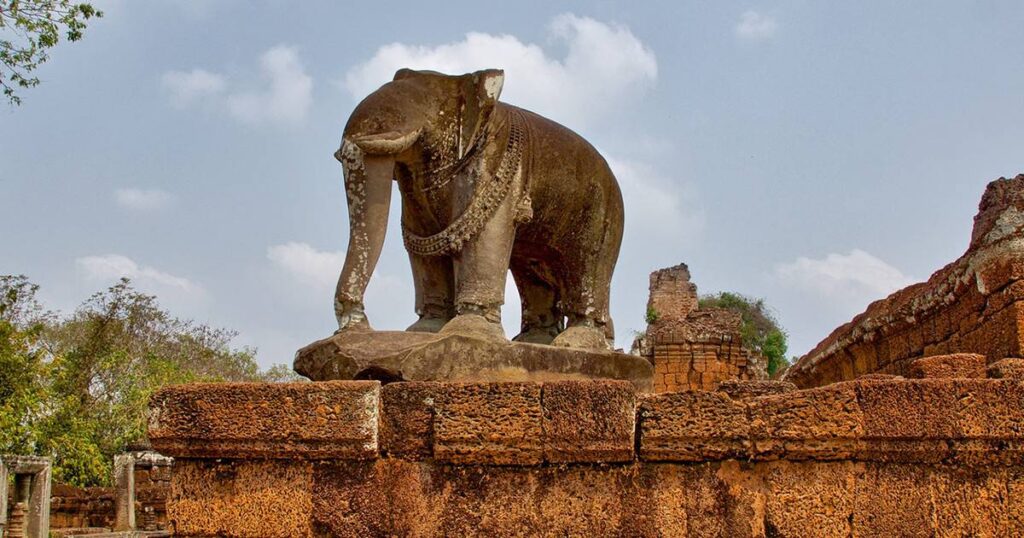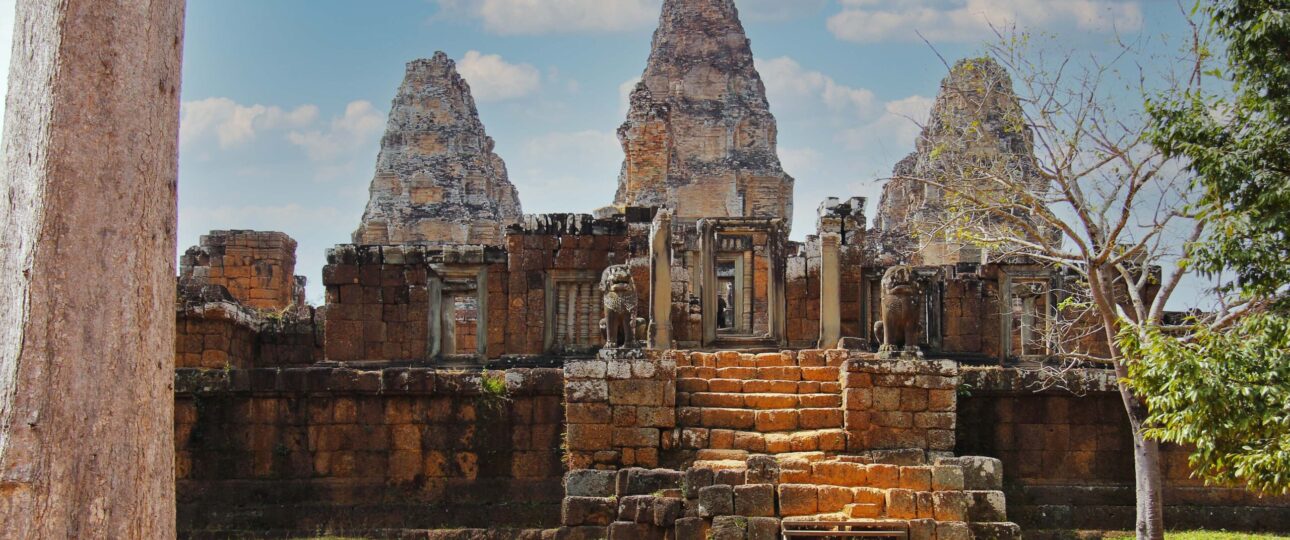East Mebon stands proudly in the heart of what was once a vast man-made reservoir, a testament to the incredible engineering and spiritual vision of the Khmer Empire. Built during the 10th century by King Rajendravarman, East Mebon was dedicated to Shiva and constructed on an artificial island at the center of the now-dry East Baray.
Though no longer surrounded by water, East Mebon still evokes a powerful sense of grandeur and symbolism, representing the sacred Mount Meru rising from the cosmic ocean.

🗝️ Key Highlights
- Built in the 10th century on an artificial island in the East Baray
- Dedicated to the Hindu god Shiva
- Constructed by King Rajendravarman shortly after Pre Rup
- Features large stone elephant sculptures at each corner
- Combines brick, laterite, and sandstone in its layered temple design
🌊 The Temple Amidst a Lost Lake
In its prime, East Mebon could only be accessed by boat. The temple was built at the center of the East Baray, a 7.5 km by 1.8 km reservoir that once provided irrigation and symbolic meaning to the Angkor heartland.
Today, the baray is dry, but the temple’s elevated location and open views of the surrounding plains offer a striking reminder of the Khmer Empire’s grand vision and hydraulic mastery.
🐘 Stone Elephants & Symbolic Design
East Mebon’s layout follows the temple-mountain format, consisting of three ascending tiers symbolizing Mount Meru. Key architectural and artistic highlights include:
- Massive stone elephants guarding each corner at the base and upper tiers
- Five main towers (prasats) on the top level, arranged in a quincunx pattern
- Beautiful lintels and carvings depicting Indra on his elephant Airavata and Shiva with Nandi
- A harmonious blend of brick sanctuaries with stucco decoration and sandstone carvings
While not as large as nearby Pre Rup, East Mebon offers a quieter, equally majestic experience.
📍 Practical Information for Visitors
- Opening Hours: 7:30 AM – 5:30 PM
- Entrance Fee: Included in Angkor Pass
- Distance from Siem Reap: 15 km northeast (approx. 30 minutes)
- Best Time to Visit: Morning or late afternoon for soft lighting
Visitor Tips:
- Ideal as part of the Grand Circuit tour
- The raised layout provides great panoramic photo opportunities
- Bring water and sun protection—there’s little shade
🙋♂️ Did You Know?
- East Mebon was built just a decade after Pre Rup by the same king and shares similar architectural features.
- The temple’s alignment with Pre Rup and Phimeanakas reflects the precise cosmological planning of the Khmer builders.
🌟 Why Visit East Mebon?
East Mebon combines artistic elegance, symbolic meaning, and historical ingenuity. With fewer crowds than the main Angkor temples, it provides a peaceful atmosphere to reflect on the empire’s engineering brilliance and spiritual legacy.
🛕 Ta Som Temple: A Quiet Jungle Treasure
Ta Som is a serene and enchanting temple tucked away in the northeastern part of Angkor’s Grand Circuit. Built in the late 12th century by King Jayavarman VII, Ta Som reflects the spiritual devotion and architectural style of the Bayon period—complete with serene face towers, crumbling corridors, and trees growing over stone.
Though smaller than Ta Prohm, Ta Som offers a similarly atmospheric experience—with fewer visitors.
🗝️ Key Highlights
- Built in the late 12th century by King Jayavarman VII
- Dedicated to the king’s father and the Mahayana Buddhist tradition
- Features face towers similar to Bayon and Ta Prohm
- Known for its massive tree growing through the eastern gopura (gate)
- Peaceful and lightly visited—ideal for quiet exploration
🌿 Nature Reclaims the Stone
The most iconic image of Ta Som is the massive sacred fig tree (Ficus religiosa) that envelops the eastern gate, roots twisting through the sandstone like natural sculpture.
This harmony of jungle and stone offers a truly magical moment, where the power of nature and the majesty of ancient architecture collide.
🧱 Bayon-Style Charm in Miniature
Though modest in scale, Ta Som encapsulates the Bayon-era aesthetic:
- Serene stone faces gazing outward from the towers
- Carvings of Bodhisattvas, devatas, and sacred lotus motifs
- A single central sanctuary surrounded by galleries and enclosures
- Crumbling corridors and partial ruins that add to the romantic atmosphere
Ta Som’s central tower and enclosing wall create a compact yet beautifully symmetrical design.
📍 Practical Information for Visitors
- Opening Hours: 7:30 AM – 5:30 PM
- Entrance Fee: Included in Angkor Pass
- Distance from Siem Reap: 20 km northeast (approx. 35 minutes)
- Best Time to Visit: Morning or mid-afternoon
Visitor Tips:
- Ta Som is ideal to pair with Neak Pean, Preah Khan, and East Mebon
- Less crowded—great for relaxed exploration and photography
- Tree gate best photographed in soft light (early morning or cloudy days)
🙋♀️ Did You Know?
- “Ta Som” means “Ancestor Som,” likely named after a royal relative
- It’s one of several temples built as acts of devotion to King Jayavarman VII’s family
🌟 Why Visit Ta Som?
For travelers seeking a more intimate, atmospheric temple experience, Ta Som is a hidden jewel. Its dramatic tree-covered gate and serene face towers evoke the mystical spirit of Angkor without the crowds. A must-see for photographers, explorers, and spiritual seekers alike.
